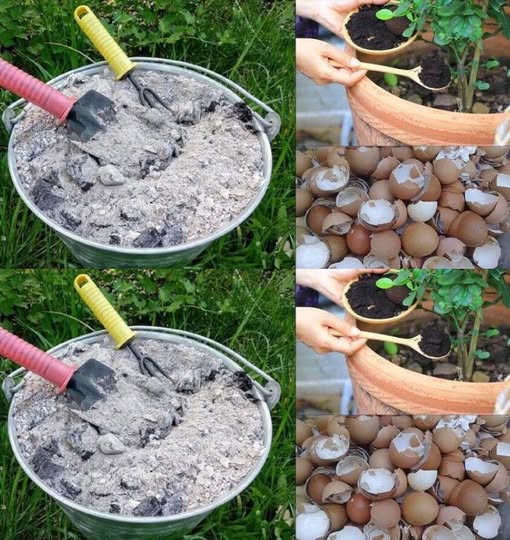ADVERTISEMENT
### 1. **Banana Peel Fertilizer**
Banana peels are rich in potassium, phosphorus, and calcium—three essential nutrients that help plants grow strong, vibrant, and resistant to diseases. This simple fertilizer will give your plants a nutrient boost without any harmful chemicals.
#### How to Make Banana Peel Fertilizer:
1. **Collect banana peels**: Gather a few banana peels (fresh or dried).
2. **Chop them up**: Cut the peels into small pieces to increase their surface area for quicker decomposition.
3. **Mix into soil**: Simply bury the chopped banana peels into the soil around the base of your plants. Over time, the peels will break down and release their nutrients.
Alternatively, you can make a **banana peel tea**:
– Soak the chopped peels in a jar of water for 2-3 days, then strain and water your plants with the banana-infused water.
### 2. **Eggshell Fertilizer**
Eggshells are an excellent source of calcium, which helps plants strengthen their cell walls and resist diseases like blossom end rot, especially in tomatoes and peppers. This easy-to-make fertilizer also adds trace minerals like magnesium and phosphorus to your garden.
#### How to Make Eggshell Fertilizer:
1. **Collect eggshells**: Save your eggshells after cooking and baking.
2. **Crush them**: Break the eggshells into small pieces or crush them into a fine powder using a mortar and pestle or rolling pin.
3. **Apply to soil**: Sprinkle the crushed eggshells around the base of your plants, or mix them into the soil when planting.
For an even more effective method, you can make an **eggshell tea** by boiling the crushed shells in water for a few minutes. Once the tea cools, use it to water your plants.
### 3. **Compost Fertilizer**
Composting is one of the best ways to create a nutrient-rich, organic fertilizer for your plants. When organic waste such as food scraps, leaves, and grass clippings decompose, it creates compost—a natural fertilizer that feeds the soil with a wide range of nutrients.
#### How to Make Compost Fertilizer:
1. **Collect organic materials**: Gather kitchen scraps (fruit and vegetable peels, coffee grounds, eggshells), yard waste (leaves, grass clippings), and other compostable items (shredded newspaper, cardboard).
2. **Create a compost pile**: Choose a well-drained spot in your garden or use a compost bin. Layer the organic materials, alternating between “green” (nitrogen-rich) and “brown” (carbon-rich) materials. Turn the pile every few weeks to help speed up the decomposition process.
3. **Let it decompose**: After several months, the compost will break down into a dark, crumbly material that’s ready to use in your garden.
Spread the compost around your plants or mix it into your garden beds to improve soil fertility and structure.
### 4. **Fish Emulsion Fertilizer**
Fish emulsion is a natural fertilizer made from fish by-products and is rich in nitrogen, phosphorus, and trace minerals. It’s perfect for encouraging healthy leaf growth and is great for vegetables and leafy greens.
#### How to Make Fish Emulsion Fertilizer:
1. **Use fish scraps**: Collect fish scraps (heads, bones, and innards) from your kitchen, or purchase fishmeal from a gardening store.
2. **Make the liquid**: Place the fish scraps in a container, cover with water, and let it sit for 1-2 weeks. Stir the mixture occasionally to break down the fish.
3. **Strain and dilute**: After a couple of weeks, strain the liquid and dilute it with water (about 1 part fish emulsion to 10 parts water) before applying it to your plants.
Fish emulsion provides an immediate nutrient boost to your plants and helps them grow quickly. Just be cautious of the smell—this is why it’s best used in outdoor gardens!
### 5. **Coffee Ground Fertilizer**
Used coffee grounds are an excellent source of nitrogen, which helps plants grow lush and green. They also provide trace minerals and improve soil structure by attracting earthworms, which are beneficial for soil health.
#### How to Make Coffee Ground Fertilizer:
1. **Collect used coffee grounds**: After brewing your coffee, save the used coffee grounds in a container.
2. **Sprinkle directly**: Spread the coffee grounds directly on top of the soil around your plants. Mix them into the soil or simply leave them on the surface as a mulch.
3. **Make coffee ground tea**: For an easier application, steep the used coffee grounds in water for a day or two, then use the resulting liquid to water your plants.
Note: While coffee grounds are great for most plants, they may be too acidic for some, like blueberries. Be mindful of the types of plants in your garden.
### Conclusion
Making your own organic fertilizers is not only cost-effective but also a sustainable way to nourish your garden. Whether you’re using banana peels for potassium, eggshells for calcium, compost for overall soil health, fish emulsion for quick growth, or coffee grounds for a nitrogen boost, these simple, natural fertilizers will promote a healthier garden with fewer chemicals.
By embracing organic methods, you can enjoy beautiful plants, a healthier garden ecosystem, and the satisfaction of growing with nature’s gifts. So go ahead—give these homemade fertilizers a try and watch your plants thrive!
ADVERTISEMENT
